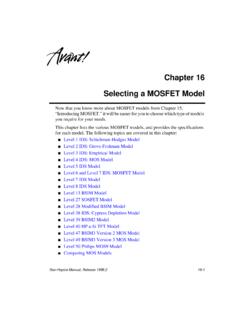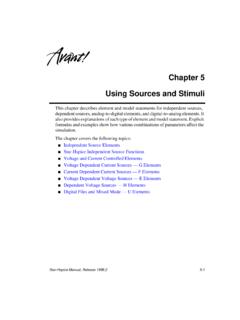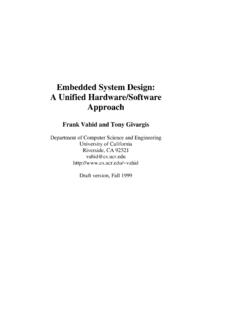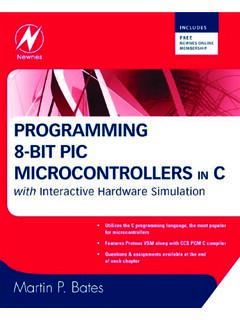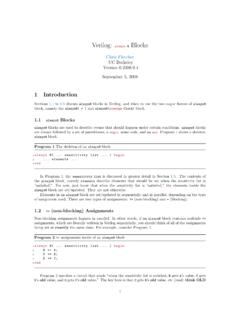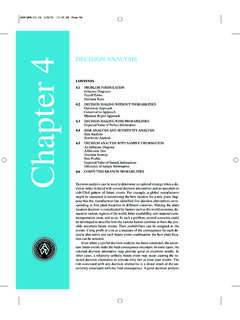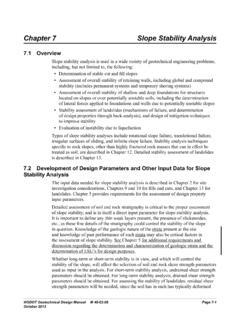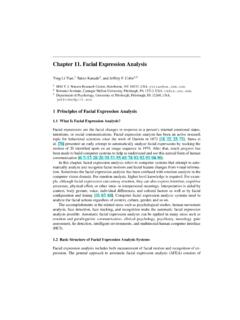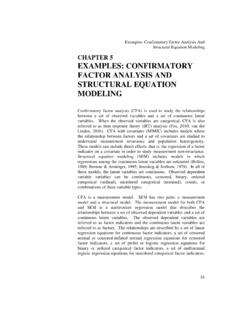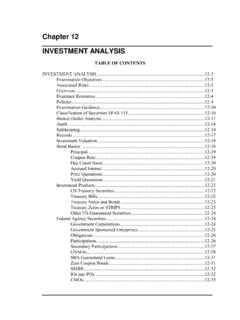Transcription of Chapter 9 AC Sweep and Signal Analysis - UWECE
1 : 1 Thu Jul 23 19:10:43 1998. Chapter 9. AC Sweep and Signal Analysis This Chapter describes performing an AC Sweep and small Signal Analysis . It covers the following topics: Understanding AC Small Signal Analysis Using the .AC Statement Using Other AC Analysis Statements Star-Hspice Manual, Release 9-1. : 2 Thu Jul 23 19:10:43 1998. Understanding AC Small Signal Analysis AC Sweep and Signal Analysis Understanding AC Small Signal Analysis The AC small Signal Analysis portion of Star-Hspice computes (see Figure 9-1). AC output variables as a function of frequency. Star-Hspice first solves for the DC operating point conditions, which are used to develop linearized, small- Signal models for all nonlinear devices in the circuit. Simulation Experiment DC Op Point DC Transient AC. Other AC Analysis AC small- Signal statements simulation.
2 NOISE..DISTO..SAMPLE..NETWORK. Options: Method DC options to solve operating-point ABSH. ACOUT. DI. MAXAMP. RELH. UNWRAP. Figure 9-1: AC Small Signal Analysis Flow 9-2 Star-Hspice Manual, Release : 3 Thu Jul 23 19:10:43 1998. AC Sweep and Signal Analysis Understanding AC Small Signal Analysis Capacitor and inductor values are converted to their corresponding admittances: YC = j C for capacitors and YL = 1/j L for inductors Star-Hspice allows resistors to have different DC and AC values. If AC=<value>. is specified in a resistor statement, the operating point is calculated using the DC. value of resistance, but the AC resistance value is used in the AC Analysis . This is convenient when analyzing operational amplifiers, since the operating point computation can be performed on the unity gain configuration using a low value for the feedback resistance.
3 The AC Analysis then can be performed on the open loop configuration by using a very large value for the AC resistance. AC Analysis of bipolar transistors is based on the small- Signal equivalent circuit, as described in Using the BJT Models (NPN and PNP) on page 14-33. MOSFET AC equivalent circuit models are described in Chapter , Introducing MOSFET. The AC Analysis statement permits sweeping values for: Frequency Element Temperature Model parameter Randomized distribution (Monte Carlo). Optimization and AC design Analysis Additionally, as part of the small Signal Analysis tools, Star-Hspice provides: Noise Analysis Distortion Analysis Network Analysis Sampling noise Star-Hspice Manual, Release 9-3. : 4 Thu Jul 23 19:10:43 1998. Using the .AC Statement AC Sweep and Signal Analysis Using the .AC Statement You can use the .AC statement in several different formats, depending on the application, as shown in the examples below.
4 The parameters are described below. Syntax Single/double Sweep : .AC type np fstart fstop or .AC type np fstart fstop < Sweep var starstop incr>. or .AC type np fstart fstop < Sweep var type np start stop>. or .AC var1 START= <param_expr1> STOP= <param_expr2>. + STEP = <param_expr3>. or .AC var1 START = start1 STOP = stop1 STEP = incr1. Parameterized Sweep : .AC type np fstart fstop < Sweep DATA=datanm>. or .AC DATA=datanm Optimization: .AC DATA=datanm OPTIMIZE=opt_par_fun RESULTS=measnames + MODEL=optmod Random/Monte Carlo: .AC type np fstart fstop < Sweep MONTE=val>. The .AC statement keywords and parameters have the following descriptions: DATA=datanm data name referred to in the .AC statement 9-4 Star-Hspice Manual, Release : 5 Thu Jul 23 19:10:43 1998. AC Sweep and Signal Analysis Using the .AC Statement incr voltage, current, element or model parameter increment value Note: If type variation is used, the np (number of points) is specified instead of incr.
5 Fstart starting frequency Note: If type variation POI (list of points) is used, a list of frequency values is specified instead of fstart fstop . fstop final frequency MONTE=val produces a number val of randomly-generated values that are used to select parameters from a distribution. The distribution can be Gaussian, Uniform, or Random Limit. See Performing Monte Carlo Analysis on page 10-39 for more information. np number of points per decade or per octave, or just number of points, depending on the preceding keyword start starting voltage, current, any element or model parameter value stop final voltage, current, any element or model parameter value Sweep keyword to indicate a second Sweep is specified in the .AC. statement TEMP keyword to indicate a temperature Sweep type can be any of the following keywords: DEC decade variation OCT octave variation LIN linear variation POI list of points var name of an independent voltage or current source, any element or model parameter, or the keyword TEMP.
6 (indicating a temperature Sweep ). Star-Hspice supports Star-Hspice Manual, Release 9-5. : 6 Thu Jul 23 19:10:43 1998. Using the .AC Statement AC Sweep and Signal Analysis source value Sweep , referring to the source name (SPICE. style). However, if parameter Sweep , a .DATA statement, and temperature Sweep are selected, a parameter name must be chosen for the source value and subsequently referred to in the .AC statement. The parameter name can not start with V or I. Examples The following example performs a frequency Sweep by 10 points per decade from 1 kHz to 100 MHz..AC DEC 10 1K 100 MEG. The next line calls for a 100 point frequency Sweep from 1 Hz to 100 Hz..AC LIN 100 1 100HZ. The following example performs an AC Analysis for each value of cload, which results from a linear Sweep of cload between 1 pF and 10 pF (20 points), sweeping frequency by 10 points per decade from 1 Hz to 10 kHz.
7 AC DEC 10 1 10K Sweep cload LIN 20 1pf 10pf The following example performs an AC Analysis for each value of rx, 5 k and 15 k, sweeping frequency by 10 points per decade from 1 Hz to 10 kHz..AC DEC 10 1 10K Sweep rx n POI 2 5k 15k The next example uses the DATA statement to perform a series of AC analyses modifying more than one parameter. The parameters are contained in the file datanm..AC DEC 10 1 10K Sweep DATA=datanm The following example illustrates a frequency Sweep along with a Monte Carlo Analysis with 30 trials..AC DEC 10 1 10K Sweep MONTE=30. When an .AC statement is included in the input file, Star-Hspice performs an AC. Analysis of the circuit over the specified frequency range for each parameter value specified in the second Sweep . 9-6 Star-Hspice Manual, Release : 7 Thu Jul 23 19:10:43 1998. AC Sweep and Signal Analysis Using the.
8 AC Statement For an AC Analysis , at least one independent AC source element statement must be in the data file (for example, VI INPUT GND AC 1V). Star-Hspice checks for this condition and reports a fatal error if no such AC sources have been specified (see Chapter , Using Sources and Stimuli). AC Control Options ABSH=x Sets the absolute current change through voltage defined branches (voltage sources and inductors). In conjunction with DI and RELH, ABSH is used to check for current convergence. Default= ACOUT AC output calculation method for the difference in values of magnitude, phase and decibels for prints and plots. Default=1. The default value, ACOUT=1, selects the Star-Hspice method, which calculates the difference of the magnitudes of the values. The SPICE method, ACOUT=0, calculates the magnitude of the differences. DI=x Sets the maximum iteration-to-iteration current change through voltage defined branches (voltage sources and inductors).
9 This option is only applicable when the value of the DI control option is greater than 0. Default= MAXAMP=x Sets the maximum current through voltage defined branches (voltage sources and inductors). If the current exceeds the MAXAMP value, an error message is issued. Default= RELH=x Sets relative current tolerance through voltage defined branches (voltage sources and inductors). It is used to check current convergence. This option is applicable only if the value of the ABSH control option is greater than zero. Default= Star-Hspice Manual, Release 9-7. : 8 Thu Jul 23 19:10:43 1998. Using the .AC Statement AC Sweep and Signal Analysis UNWRAP displays phase results in AC Analysis in unwrapped form (with a continuous phase plot). This allows accurate calculation of group delay. Note that group delay is always computed based on unwrapped phase results, even if the UNWRAP option is not set.
10 AC Analysis Output Variables Output variables for AC Analysis include: Voltage differences between specified nodes (or one specified node and ground). Current output for an independent voltage source Element branch current Impedance (Z), admittance (Y), hybrid (H), and scattering (S) parameters Input and output impedance and admittance AC output variable types are listed in Table 9-1:. The type symbol is appended to the variable symbol to form the output variable name. For example, VI is the imaginary part of the voltage, or IM is the magnitude of the current. Table 9-1: AC Output Variable Types. Type Symbol Variable Type DB decibel I imaginary part M magnitude P phase R real part T group delay Specify real or imaginary parts, magnitude, phase, decibels, and group delay for voltages and currents. 9-8 Star-Hspice Manual, Release : 9 Thu Jul 23 19:10:43 1998.



